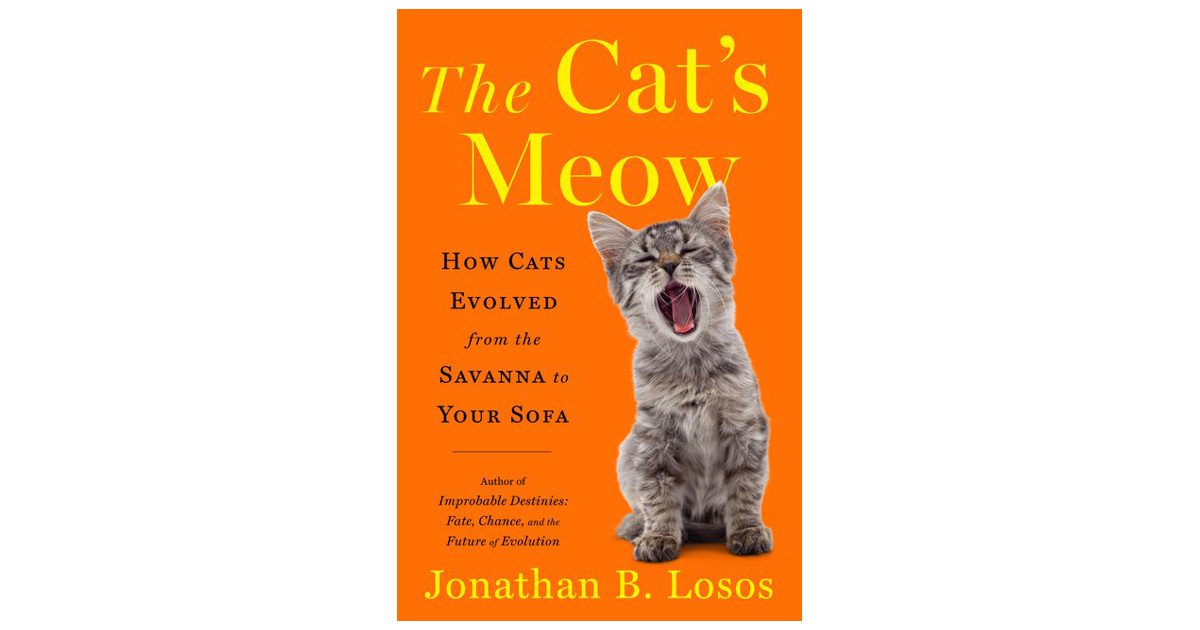
May 16, 2023 “The Cat’s Meow: How Cats Evolved from the Savanna to Your Sofa” by Jonathan B Losos
Book Review
Jonathan Losos is an evolutionary biologist who has reached the pinnacle of achievement for a US research scientist, election to the US National Academy of Sciences. He is best known for his work on lizard adaptations and evolution – specifically the anole lizards of the Caribbean islands. However, he is also a life-long cat-lover or ailurophile. That trait led him to write The Cat’s Meow (Viking, New York, 2023), a book combining his interest in and attraction to cats and his career as an evolutionary biologist.
The book leaves no doubt about either Losos’ fascination with all things feline or his considerable skill in explaining the technicalities and challenges of evolutionary theory and DNA analysis. Biographical online material describes Losos as a skilled teacher and student mentor. Those qualities shine through in his writing.
Losos describes how he became fascinated by cats and caught up in the world of cat science, teaching a first-year course on cats at Harvard. His goal in teaching the course was to attract student interest by focusing on cats (who could resist such a course) and “then, when they weren’t looking, … teach them a lot of cutting edge science…while they thought they were learning about felines.” According to Losos, this strategy worked like a charm. The students learned a tremendous amount about cats and along the way, they also learned how modern-day evolutionary biologists studied biodiversity. This strategy not only worked on the students – it also worked on Losos! The Cat’s Meow is the result of all the fascinating material Losos unearthed from scientific studies on the origins of domestic (or not so domestic) cats and from the modern cat fancy community and the many breeds of cats that humans have crafted in the past hundred to hundred and fifty years.
The book fittingly starts with discussing its title, namely, feline vocalization and, specifically, the meow. His search led him to a graduate student at Cornell whose doctoral dissertation examined whether different cat meows were meaningful and whether human subjects could listen to the meows and correctly identify the context of the calls (there were five options). The results indicated that people had, at best, a limited ability to identify the contextual meaning of a cat’s meow, even though it is known that any given cat has an extensive repertoire of different meows. However, the people who lived with a particular cat could identify the context of their cat’s meows at a rate that was much greater than chance. Losos also discusses a cat’s other marquee sound, the purr. He notes that all small cat species can purr but concludes that, just as with the meow, domestic cats have modified their purr to better communicate with humans. [It is not just small cats who purr. While visiting a wildlife rescue operation, I had an opportunity to stroke a tiger through the bars of its cage. The tiger started purring, sounding like a small two-stroke engine!]
The book is full of fascinating observations about cats.
For example, the African wildcat (from whom present-day tabbies evolved) is among the friendliest of wild felids, whereas the European wildcat is reported to be among the unfriendliest, even though the two have historically been considered members of the same species. Cat body language is also essential. A cat with a raised, upright tail (whether a pet cat or a lion on the African savannah) sends a message that it is approaching in friendship.
As an evolutionary biologist, Losos also spends time on the purported origins of current domestic cats. Many small wild felids might have given rise to today’s house cat, and deciding which one (or more than one) might have been the source of all domestic cats is not a simple task. However, modern DNA techniques provide an opening to identify different species and the relationships between species. Losos describes a PhD project (and its logistical challenges) that collected DNA samples from cats worldwide to determine an evolutionary tree for cats. The project discovered that there are not three (African, European, and Asian) but five wild cat species. The African Wild Cat consists of two genetically distinct populations – the North African and South African Wild Cats. These two populations have been genetically different for more than 100,000 years. The fifth Wild Cat species is the poorly studied Chinese Mountain Cat (found on the Tibetan plateau). Two additional chapters explore the puzzle of the origins of today’s domestic cats and whether there was more than one domestication event. In the process, we learn about the veneration of cats in Ancient Egypt and the practice of cat mummification.
Anybody interested in cats will find Losos’ book an excellent resource on all things Felis catus, not to mention the many insights provided into evolutionary biology. Losos had also originally intended to include the challenge of domestic cat management in the book. This is a vigorously contested issue worldwide, with conservation biologists and animal protection advocates arrayed in opposition to each other. However, Losos decided he could not do the topic justice in a few chapters and limited himself to three observations. First, unowned domestic cats are responsible for the lion’s share of the feline predation toll. Second, conservationists and cat protection advocates care about animals, so it would seem they could work together, but “the proposed solutions are radically different and compromise has been elusive.” Third, for pet cats, “keeping cats indoors is better for them and the environment.” However, elsewhere in the book, Losos admits that confining some cats indoors may be easier said than done!
It is a wonderful book. Losos is an inspirational guide to all matters, feline!


